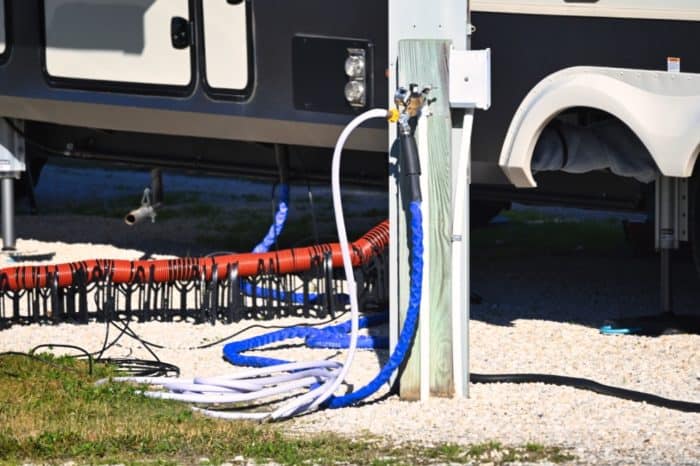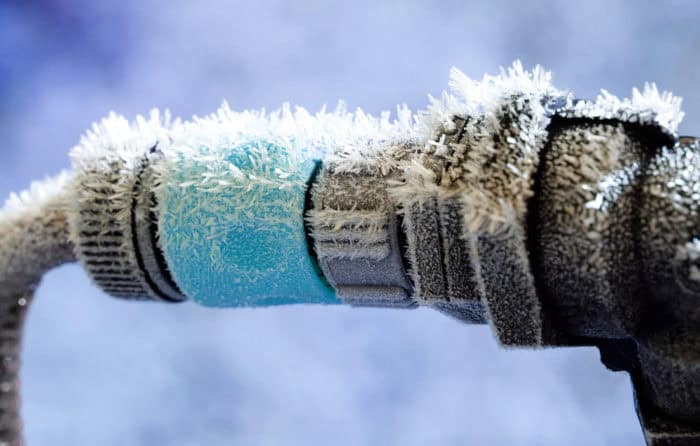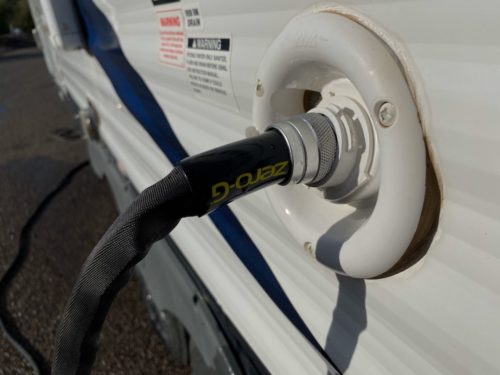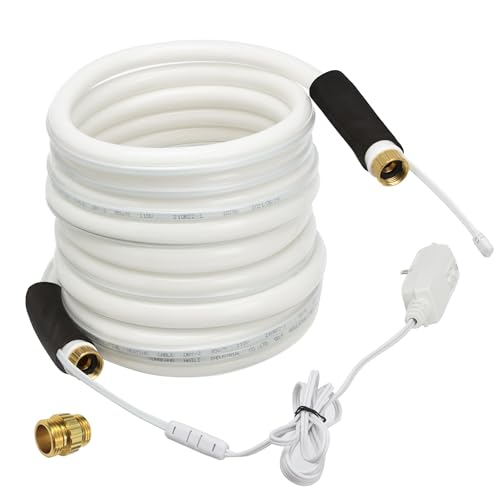Which Is The Best Heated Water Hose For RVs, Campers & Barns
As the winter is approaching and the temperatures are starting to fall below freezing, RVers and campers on the road start to worry about water hoses and pipes freezing.
While homeowners with gardens, barns, livestock, and horses might be used to dealing with this, RV travelers might not be since a lot of us do our best to stay away from freezing temperatures.
But that doesn’t mean that some enjoy camping in the cold.
Related Product: Did you know RV Propane Detectors (click to view on Amazon) need to be replaced every 5-10 years? Make sure yours is still up to date before your next camping trip.
One of the best ways to prevent your hose and plumbing from freezing is to get a heated water hose.
Some hoses have more features than others, but a heated water hose basically keeps a hose from freezing electrically.
The best hoses use thermometers to monitor the outdoor temperature to not heat the hose when it’s not freezing. It helps not waste electricity and prevents overheating.
The cheapest hoses don’t have features like this and stay on until you unplug them.
One thing most of the hoses have in common is that they are more insulated than a regular drinking water hose.
Just like a regular hose, heated hoses come in different lengths. The shortest hoses I have seen are 25 feet, and the longest 100 feet.
With the help of some extension cords and adapters, you can connect several hoses together. This could be necessary for livestock or horses in barns.
Before connecting an extension cord, you need to talk to the manufacturer of your specific hose to make sure it’s ok to use an extension cord.
Related Post: If you’re looking for a heated water hose for long-term use, check out this post.
There is obviously a price difference between the different lengths, so you should consider how long of a hose you actually need before making a purchase.
Now, let’s take a look at and review the best heated water hoses available right now.
My Choice
Last update on 2024-04-17 / Affiliate links / Images from Amazon Product Advertising API
Best Headed Drinking Water Hoses Reviews & Info
1. Camco Cold Weather Heated Drinking Water Hose
We’ll start out with a brand that most of you will recognize, Camco.
They make tons of RV accessories and parts and you might own some of their products already.
Camco makes two different models. One can handle temperatures down to -20 degrees Fahrenheit (-28 C), and the second can handle down to -40 degrees Fahrenheit (-40 C).
The second one is a little more heavy-duty, but unless you know you might be in lower than -20 degrees I would go with the first one.
The 120V AC cable plugs into a regular household outlet, either into the power pedestal at the campground, or an outlet at your house.
Both models come in different lengths, 12, 25, and 50 feet. The inside diameter is 5/8″. All of the hoses use an all-weather PVC coating for durability.
See Also: Best Heated RV Sewer Hose Review For Winter RV Camping
So is it safe to drink the water going through this hose?
Yes, it’s lead, BPA, and phthalate-free. It’s made with NSF 61 certified materials.
Thick heavy-duty fittings make the hose easy to handle even while wearing gloves and an included adapter will let you connect either end of the hose to the water supply.
This is nice of Camco to include since sometimes you might want to plug the cord into the RV and sometimes the power box might be right next to the water supply.
It can also be necessary if you want to connect two of these hoses together.
The power cord is 6 feet on the -20 model, and 10 feet on the -40 model.
PROS
- Withstands Temps Down To -20˚F (-28˚C) or -40˚F (-40˚C)
- Heavy Duty Fittings
- 6/10 ft Power Cord
- Safe for potable/drinking water purposes
- Free from BPA, phthalate
- Includes adapter (connect either side)
- Different Lengths to choose from
- LED Indicator on the AC plug
2. H&G lifestyles Heated Water Hose for RV
The H&G Lifestyles heated water hose works a little bit differently than the Camco hose above.
This one only comes in one length, and that is 25 feet. The inner diameter of the hose is 1/2″.
Instead of a thermostat, it has a self-regulated heat source that makes sure that the water doesn’t freeze, but also doesn’t get too warm.
It protects and prevents water from freezing down to -40˚F (-40˚C) which makes it a great option for RVers or homeowners that experience extremely cold winters.
The heating cable that’s insulated within the hose has a constant temperature of 158 degrees Fahrenheit.
See Also: Best Small Portable Propane Heater For Indoor & RV Use
The hose itself is safe to use with drinking water and can handle up to 180 psi, which is higher than most cheaper hoses.
It’s also insulated with an exterior jacket, which will further prevent the water from freezing
H&G Lifestyles includes an adapter so you can use either end of the hose depending on where you have access to power.
To set it up, just connect it to the hydrant or water source, and plug the 120V AC cord in.
The power cord is 10 feet long.
The H&G Lifestyles hose comes with an 18-month warranty.
PROS
- Withstands Temps Down to -40˚F (-40˚C)
- Heavy Duty Fittings
- 10 ft Power Cord
- Safe for potable/drinking water purposes
- Includes adapter (connect either side)
3. Api 25 Foot Heated Hose H25
Api might not be a company you’ve heard of before, but I think their heated water hose is worthy of being on the list.
It can handle temperatures down to -40˚F (-40˚C) without freezing and uses a thermostat to control itself.
It’s only available as a 25 feet hose, but you could connect two or more together as long as you have a way to connect the power cord.
See Also: How Long Will An RV Battery Run The Furnace? + Calculations
The heating wires follow the hose to prevent the water inside from freezing. It’s not further insulated like some of the other options.
It’s safe for potable/drinking water use, which makes it a great option not only for RVers but also for homeowners with horses.
Overall, the Api hose is a simple yet functional hose that will do the job for most campers.
I view the Camco hose as a better option due to the extra insulation, the LED plug, and the NSF-61 certification though.
PROS
- Withstands Temps Down to -40˚F (-40˚C)
- Safe for potable/drinking water purposes
- Brass garden hose fittings
4. Valterra W01-5325
Valterra is another company that makes a lot of RV accessories, and that includes a fantastic heated hose that’s safe for drinking water.
They make this heated water hose that comes in three lengths, 15, 25, and 50 feet.
How it works is that it uses a self-regulating heating source that will apply more or less heat depending on how cold the hose is.
The inside diameter of this hose is 1/2 in which is slightly smaller than the other two which have 5/8 in.
See Also: Best Portable Quiet Inverter Generators
To set it up, you’ll connect the water hose to a source, then plug the 120V AC plug into either the power pedestal at the RV park or campground, or to an outlet in your home or barn.
The fittings are somewhat heavy-duty, with an interesting zippered cuff on the edge for extra protection.
I have not been able to find any information about what temperatures this hose can handle.
Overall, the Valterra W01-5325 is a hose that will do the job, but without knowing the temperature limits I can’t recommend it as the best option for use in below-zero temperatures.
PROS
- Self-regulated heated hose
- Safe for potable/drinking water purposes
- Available in different lengths
- Zippered cuffs at the end for extra protection
- LED Indicator on the AC plug
5. Giraffe Tools Heated Drinking Water Hose
The Giraffe Tools heated drinking water hose is another great option for home and RV use.
It has a self regulating system that will lower or raise the temperature of the heat cable in relation to the outside temperature.
It’s rated for temperatures as low as -20°F. There’s also a heavy duty option (click to view on Amazon) available that can withstand freezing temperatures as low as -40°F.
The inside diameter of the hose is 5/8 inches.
Much like the other heated RV water hoses in this review, Giraffe Tools has a female garden hose connector on each end of the hose.
It’s so you can choose where you want the power cable to be. Sometimes the outlet you plan on using is closer to the RV, and sometimes it’s closer to the hydrant.
There’s a male to male garden hose adapter included so you don’t need to buy any extra parts to connect it to your RV or spigot at home.
See Also: 6 Best Diesel Heaters For Campers, RVs & Vans
The power cord is 6 feet long and has a GFCI protector built into the plug head. This is to help protect the electrical part of the hose if it breaks or is damaged by water.
The GFCI protector has a reset button on the power cord head. Because of the GFCI, you may want to check this hose regularly to make sure it’s still working.
The Giraffe Tools RV heated water hose is a great option for winter RV camping.
I would like to see a bit more insulation or a more protective sleeve around the hose, but for moderate winter conditions, this is a great choice.
PROS
- Self-regulated heated hose
- Safe for potable/drinking water purposes
- Available in different lengths
- Cuffs at the ends for extra protection
- GFCI Protector

Conclusion & Heated Water Hose Recommendations
There are not a ton of choices when looking at heated water hoses for your camper, but to me, there is a clear winner.
My pick – Camco Cold Weather Heated Drinking Water Hose
The Camco cold weather heated hose is a great choice that comes with everything you need to ensure that your water hose won’t freeze.
It comes in different lengths and models depending on what you need.
The more heavy-duty hose comes with a longer power cord and is more insulated.
One of the biggest reasons I recommend it over the others is the NSF-61 certification which tells me that it’s an excellent hose for drinking water use.
And if you need a 100 feet heated hose, you can connect two together with ease.
You just need to use an extension cord to be able to plug both in.
Make sure to contact the company and ask whether it’s ok to use an extension cord or not.
See Also: How To Stay Warm In An RV At Night Without Using The Furnace
How I Made My Own Heated Water Hose
What I recommend doing to stop your freshwater hose from freezing is wrapping it with a heating cable.
Most of us have hoses that we use in the summer that we like and want to keep using instead of splurging for a completely new hose with some heating cables.
Note that not all RV parks and campgrounds allow DIY heated hoses, for safety reasons.
If you’re staying at an RV park right now long-term, you should talk to the management before purchasing anything.
I also want to say that doing any DIY setup is done at your own risk, and everything below is not a how-to guide, but just information about how I did it.
Here is what I use to prevent my freshwater hose from freezing in temperatures down to 0˚F
Heating Cable
You can find heating cables in a lot of home improvement retail stores, but the one I am using right now is the HEATIT JHSF 40-feet (click to view on Amazon).
My water hose is 25 feet and using a 40 feet heating cable is enough.
I bought one 15 feet longer than my water hose so I could wrap it completely around both the water source and the end of the hose going into the trailer.
When I don’t use the full 25 feet (I usually have several feet left) at the campground, I put the rest of the hose in a plastic bag with the heating cable.
That could be hard with some hoses, the one I have is the Teknor Apex Zero-G (click to view on Amazon).
Depending on the quality of the hose, it might not like heat for an extended time. I only use high-quality hoses for this reason.
The HEATIT heating cable has an included thermostat that will start and stop heating when needed.
You can zip-tie, tape with 3M Glass Electrical Tape (click to view on Amazon) or wrap it around your water hose.
You could also use an insulation pipe below like I do to stuff both the hose and heating cable in.
See Also: How To Find Nearby Dump Stations And Fresh Water
Insulation Pipe
I use foam pipe insulation like this (click to view on Amazon).
The easiest thing, in my opinion, is to get an insulation pipe like this to put the hose and heating cable in.
Not only does it insulate, but it makes sure that the heating cable is right on the hose and heats it accordingly.
The foam pipe insulation I use has an inside diameter of 1 inch and comes in 6 feet.
Pool noodles also work, but I can’t say if they insulate as well. It’s basically the same thing though, foam. The density might be different.
VIVOSUN Bubble Film Pipe Insulation
You can take it an additional step if you’re in really low temperatures or would rather use this instead of insulation pipe.
Wrapping this around a hose will help prevent it from freezing and you could even wrap this around the insulation pipe, or put it inside with the hose and heating cable.
Note that you might need a slightly thicker insulation pipe to fit it all.
How To Prevent Your RV Hose, Tanks & Pipes From Freezing
Since we’re on the topic of freezing cold weather and how to prevent damage to your water hose, I figured I might as well share some general tips on how to prevent damage to an RV due to freezing temperatures.
These are related to RVing, but some of these things are just as important in a barn or even a house.
If you have any tips, please leave a comment and let me know and I will update the article.
Here are my tips:
Monitor Both Indoor and Outdoor Temperatures
How cold is it outside? Do you even need a heated hose?
Well, the easiest way to know if you’re in trouble or not is by investing in a small weather station.
I like this one by Oria (click to view on Amazon) that comes with three sensors, so you can put them where you’re worried about freezing temperatures.
For example, you could keep one outside, one around your water heater, and one under your camper if it has a skirt.
By knowing how cold it is and where, you can think strategically and turn on the hose, water heater, or faucets as needed.
You can also save a lot of electricity by not running heaters and appliances when it’s not necessary.
Use a Heated Water Hose, or Make Your Own
Well, this should be clear by now, but one of the best ways to prevent damage to your RV plumbing and pipes due to freezing temperatures is with a heated water hose.
This will mostly keep the water outside of your camper warm, but it will also help keep the RV plumbing warm as long as you run the faucet every now and then.
You should still monitor how cold it is both inside and outside, but getting a hose like this is a great first step.
See Also: Den-Dry Mattress Underlay Review – Stop RV Mattress Mold
Keep Water in Tanks and/or Use Heated Pads
A fresh, black, or grey tank with a little bit of water is going to freeze pretty fast in freezing temperatures unless they’re heated.
A frozen holding or waste water tank can be really bad news since it might crack.
Keep all of your tanks at least half-full when it’s going to be below freezing.
If you’re going to be spending several winters in your camper, you might want to install RV water holding tank heater pads (click to view on Amazon).
These are 12V and have an automatic thermostat control.
Make Sure the Water Source Doesn’t Freeze
The spigot or hydrant can freeze. Insulate it, or wire heat wire around it.
Most water hydrants are designed to not let any water go above the frost line until you turn it on.
But if left on for a while in freezing temperatures without enough flow, it can freeze.

If you’re at an RV park, talk to the camping host about this and ask what they do to prevent frozen pipes.
Some spigots are heated and don’t need any extra insulation, but you should talk to the campground owner or host to be sure.
Leave Cabinet and Pantry Doors Open
Even though it feels warm inside your RV, the pipes going along the walls behind cabinets might be cold and freeze.
Based on my experience this is especially true at night. Therefore, I recommend checking your cabinet, pantry, and drawers.
Can you see any pipes in there? If so, leave these open as much as possible when it’s really cold.
Turn On the Hot Water Heater
The previous owner of my travel trailer was camping up in South Dakota in the winter and forgot to turn on the hot water heater one night.
He woke up with water on the floor, because the hot water heater tank had cracked.
Make sure that the hot water heater is on, or has been on recently if it’s even close to freezing outside.
Run the RV Furnace
Yes, it’s an obvious one, but keep your furnace or heaters going.
My camper has a “heated underbelly”, which in my case means that the furnace duct is close enough to the tanks to keep them somewhat warm.
If your RV or trailer is a 4 season camper, the holding tanks and pipes are usually more insulated to prevent them from freezing.
It might even have heated pads installed on your holding tanks.
Leave Faucet/Spigot On
This isn’t allowed everywhere, especially not in every RV park or campground, since it’s so wasteful.
But you could leave a faucet or spigot on to keep the water moving in your pipes.
Just remember to leave your grey tank open if you’re in a camper, so you don’t overflow it.
Get a Skirt For Your RV or Camper
RV skirts are installed on the outside and keep everything below your RV warmer.
This also keeps the inside of your RV and storage compartments warmer.
I recommend the EZ Snap skirt systems.
See Also: Best Portable Electric Heated Blankets For Camping
Frequently Asked Questions About Heated Water Hoses
Do I need a heated water hose?
If you’re going to be leaving the water hose out in temperatures below freezing (32˚F, 0˚C) then yes, you should definitely have a heated water hose.
If you only go fill up the fresh tank you’ll want to make sure you have an insulated fresh water tank or enclosed tank bay at least to prevent your fresh tank from freezing.
There are heating pads that you can install on your holding tanks for this purpose as well, like these ones by RecPro (click to view on Amazon).

How do you connect a heated hose to a camper?
It connects the same way as your regular water hose.
The only difference is that it also has a plug on one side that you need to connect to the pedestal, your camper, or an outlet in your garage or barn.
As soon as you plug it in, the hose will start doing its thing and heat up.
You could also plug it into a gas generator.
Can a heated water hose be buried?
I wouldn’t do this without talking to the manufacturer of the specific heated hose first.
It’s fine to bury a regular water hose to prevent it from freezing as fast, but since a heated hose is electrically heated I would be more careful.
Also, unless you’re camping in extremely low temperatures I wouldn’t bother trying with a heated hose.
They do a good enough job of keeping the water from freezing without burying them.
Should the hose be plugged in when it’s no longer freezing outside?
If the hose is self-regulated or has a thermostat, you can leave it plugged in. But it also depends on how warm it is outside.
If it’s going to be above 40 degrees Fahrenheit for the next 24 hours, I would unplug it to save electricity, but unless you know that for sure I would leave it plugged in.
Can I leave the hose turned on without water in it?
It depends on the quality of the hose and materials. It’s fine with most, but it shouldn’t be left like this for a long time.
To be sure, ask the manufacturer of your specific hose brand.
Will a heated hose protect the pipes inside my camper?
It will make the water in the hose warmer, which includes the water in the RV pipes.
But as with everything, it depends on how cold it is outside and inside your RV. If it’s freezing inside, your pipes are going to freeze eventually.
The best thing you can do to prevent your RV plumbing from freezing is to run the faucets with warm water and keep the inside of your RV warm.
You should also leave the kitchen cabinets (if the pipes go through there) and doors open so warm air can circulate.
You should not assume that the heated hose is going to protect your pipes.
How long are heated water hoses?
They come in many different lengths. I have seen 15, 25, 30, 75, 100, and 200 feet hoses.
Not all brands sell different lengths.
Can you combine two heated hoses?
Yes, in most cases. You should ask the manufacturer of your specific hose to be sure.
The tricky part is to get electricity to both hoses, but that can be done with extension cables. Just make sure the power cords are rated for outdoor use.
You should also talk to the manufacturer to make sure that it’s ok to use extension cords with your specific hose.
How hot is a heated hose to the touch?
If it’s cold outside, it feels warm. But it’s not hot to the touch, and won’t burn you.
It does make the water inside the hose warmer than usual, which can be nice in a camper during the winter.
How much does it cost in electricity to use a heated water hose?
These types of electrically heated hoses use 5-10W per foot on average. So a 50 ft hose will draw about 300-400W.
The national average retail electricity price per kWh is 10.48 cents, so a 50 ft heated hose would cost from $0.75 to 1.01 per day.
The actual cost is going to depend on the length of the hose, what you pay per kWh, and how cold it is outside.
How do I prevent my RV plumbing and holding tanks from freezing?
You have to remember one thing when it comes to RV plumbing. Just because it’s warm inside your RV doesn’t mean it’s warm where the pipes are.
If the water in your plumbing freezes, it will expand and crack the pipes.
Modern RV pipes are great because they can expand a bit without cracking, but we will want to prevent them from freezing.
So the best way to keep your hoses and pipes safe is to not leave your city water hose connected to the RV when it’s the coldest, usually at night.
If you have a compartment on the side of the RV where you fill up your freshwater, you should definitely put a heat lamp in there.
You could even use an aquarium bulb to heat up the small compartment.
Just make sure it’s not too hot after leaving it there for a while. I have seen insulation and other pipes melt due to heat lamps getting too hot.
You can put insulating material around the bottom of your RV to keep the temperatures underneath your camper higher and keep debris/snow out.
It’s called RV skirting, and it can be done with any kind of insulation. A popular material for DIY RV skirting foam insulation (click to view on amazon) taped together with weatherproof aluminum foil tape (click to view on Amazon).
A skirt together with a heat lamp can prevent holding tanks from freezing.
Of course, the lower the temperature, the harder it will be to keep above freezing temperatures.
RV skirts are one of the best ways to prevent freezing pipes underneath your camper.
Wrapping any exposed pipes in heat tape is also a good idea.
What are the best RV heated hose brands?
I would say that the best reputable companies that make these types of hoses are Camco, Pirit, Valterra, and NoFreezeWaterHose.
Click here to see a full review of the NoFreezeWaterHose
Do I need to fill the heated water hose with water before turning it on?
It depends on the hose, but in most cases, it’s fine to turn the hose on without water inside the hose. Ask the manufacturer of your specific hose.
Even though it’s fine to do, I wouldn’t leave it turned on for an extended amount of time without having water in it.
Will one freezing night be enough to hurt?
Yes, it only takes one freezing night to freeze and crack your water hose.
If it’s not expected to go under 30 degrees, I recommend filling your fresh water tank for the night.
If you have a heated or insulated tank, you can fill your fresh water even when it’s under 30 degrees.

I hope you’ve learned a thing or two about protecting your hoses and RV, let me know down below if you have any questions or tips on how to handle cold temperatures when camping.









We love the articles written on this website. They are so detailed and informative for sure. Thanks for the great job you do! If I could make a request though, I would like to know is whether products are made in the USA or not. It’s our preference.
As for the Camco models, we’ve been using them for 4 years solid now. BUT…and there is a BUT…we have to replace them EVERY year. We are full timers. They get use a lot. The fittings ALWAYS break. They are cheaply made in China (of course. What’s not?). The interior jacket ALWAYS fills up with water. Water is not a nice thing to have in the floor of your RV when you put it away. One thing we do benefit from though…Every year, I could just throw them away. Instead, I cut off the outer jacket and save the heat trace. It comes in handy to put on faucets, drain lines, etc.
OR,
If you buy them at Camping World with the extended warranty, you’re almost guaranteed to return it every year for a new one…